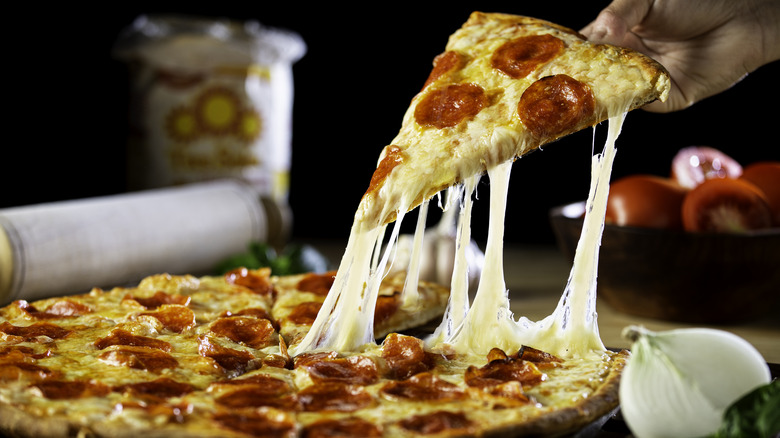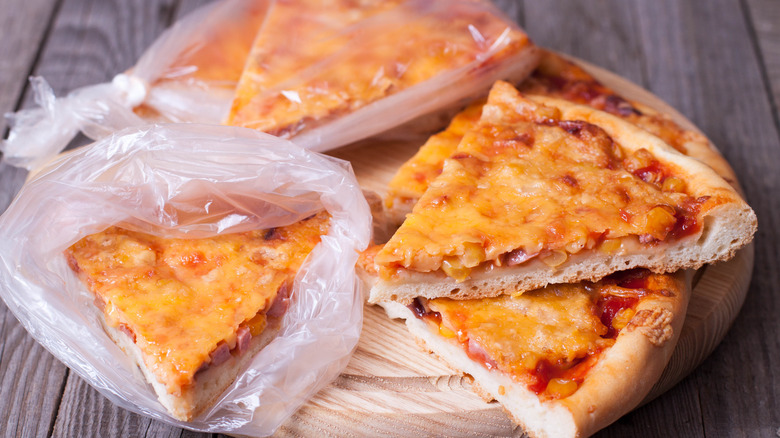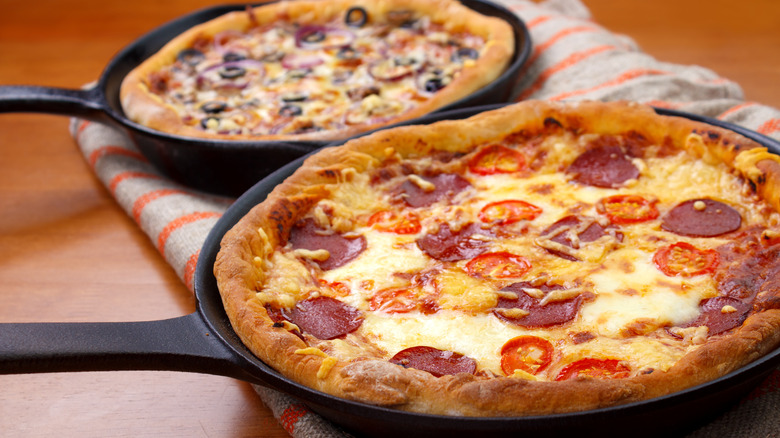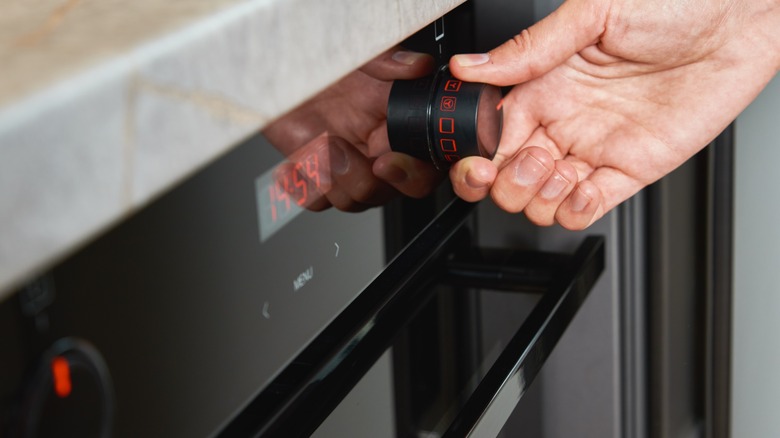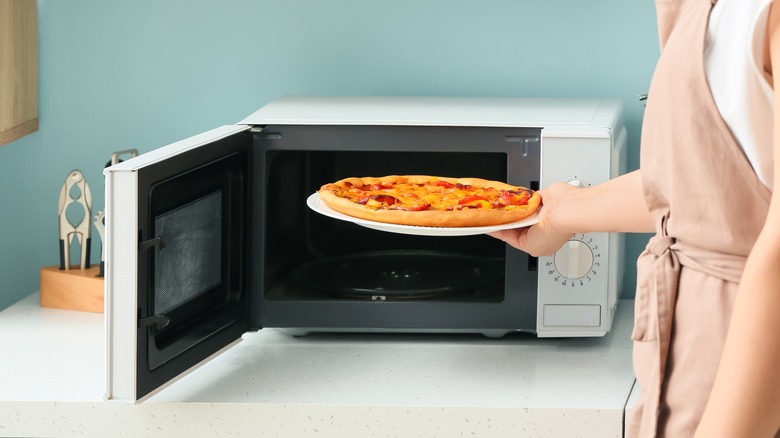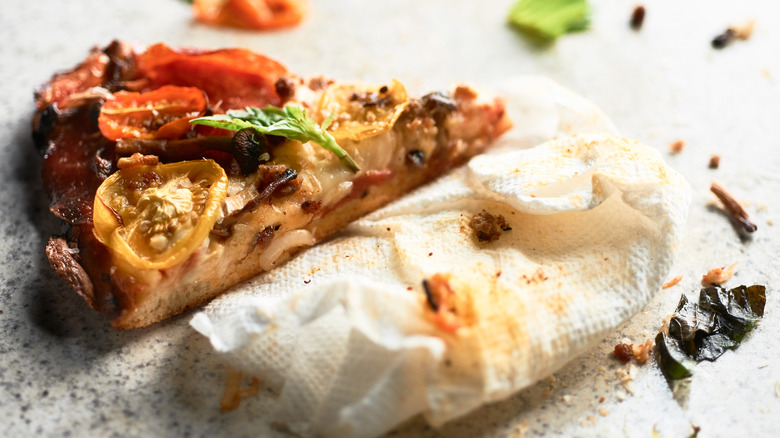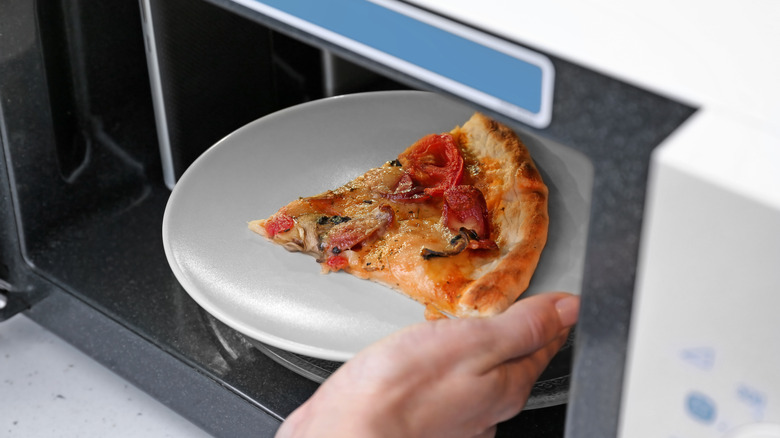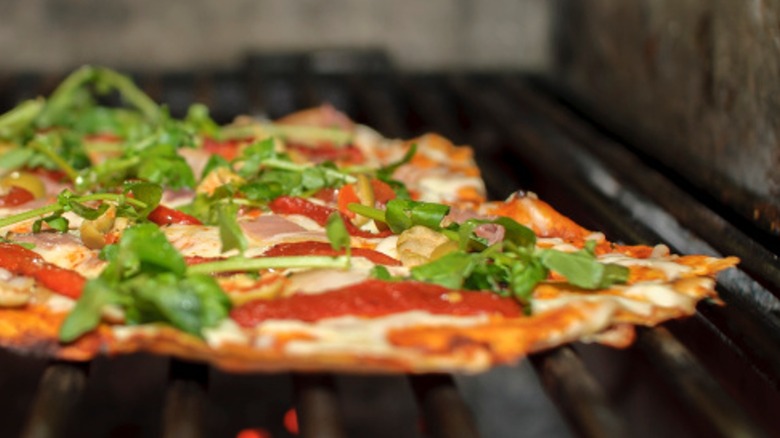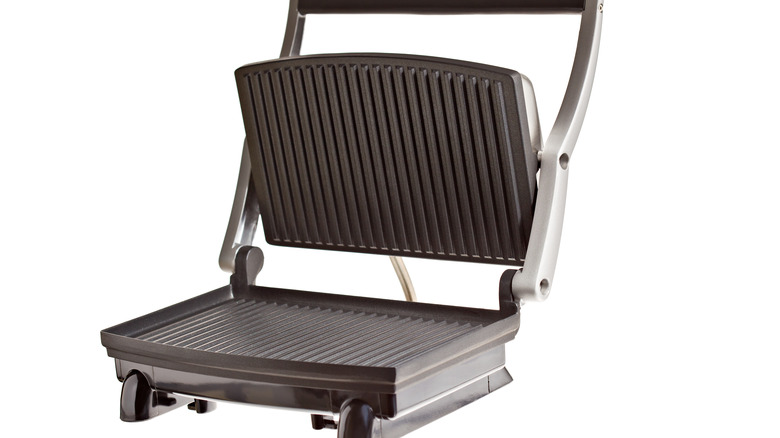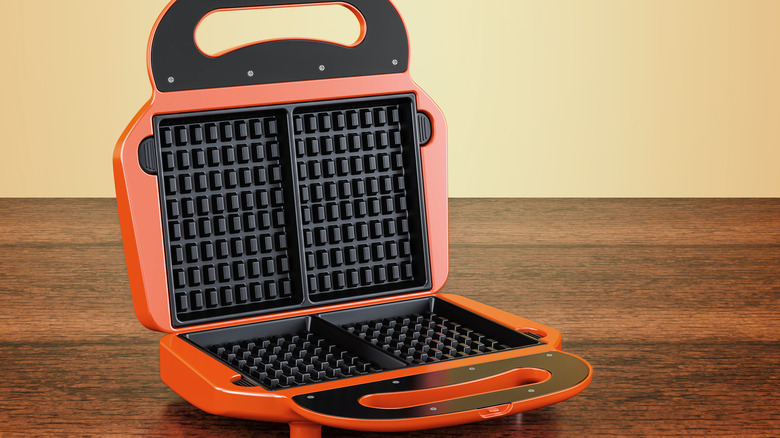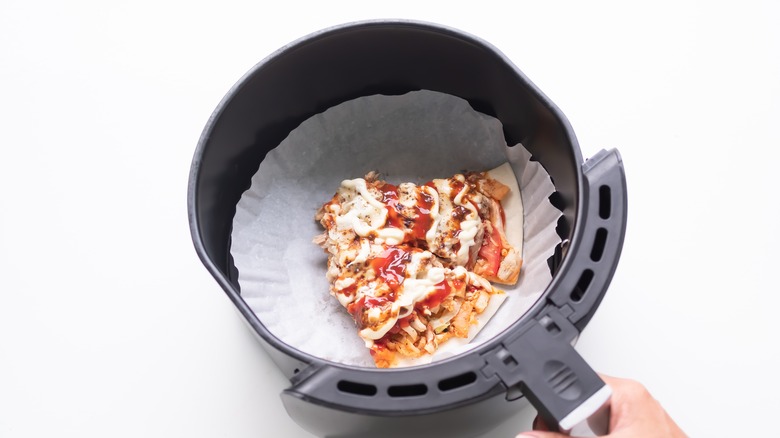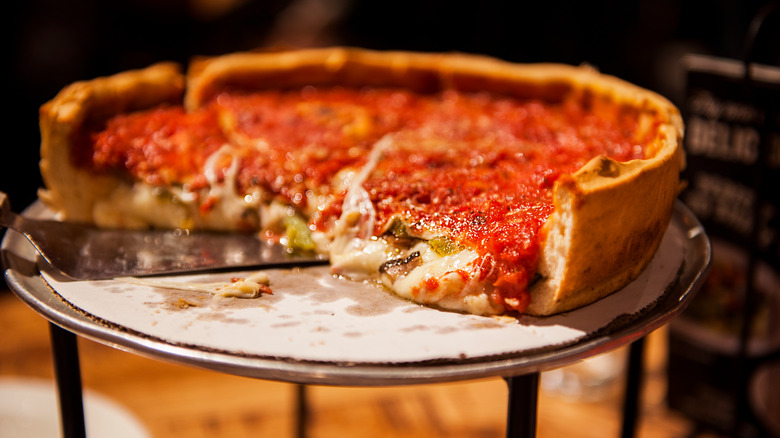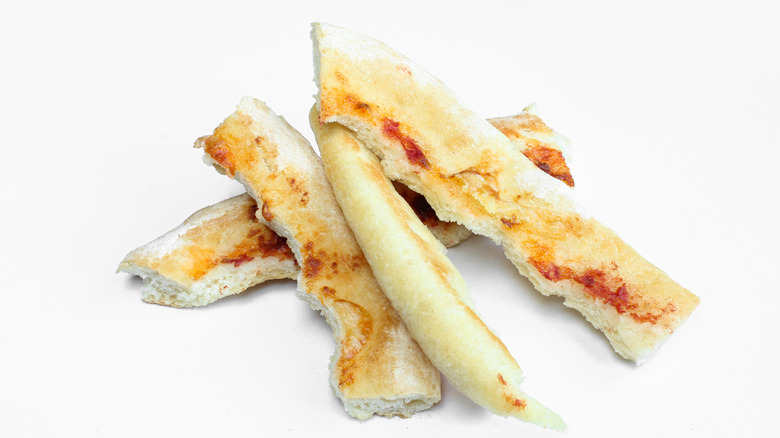14 Best Tips And Tricks For Reheating Pizza
With some delivery pizzas measuring a foot or more in diameter, it's no wonder many of us find ourselves with leftovers. Don't get us wrong — we're definitely fans of leftovers, but reheating pizza can be challenging. Unlike casseroles, meatloaf, and soups that reheat well and may even taste better after a night in the fridge, reviving pizza takes finesse and skill. If you fail to follow proper pizza reheating protocol, you'll end up with rubbery cheese, a dry crust, or an unevenly heated slice.
Fortunately, it doesn't have to be this way. As pizza lovers, we've scoured the internet for tried-and-true tips and tricks to guarantee that your day-old pizza tastes just as good as when it first arrived at your doorstep. In addition to conventional methods like oven reheating, we'll delve into innovative approaches like using an air fryer or a panini press to breathe new life into your pizza. So, grab a slice and follow along as we explore the subtle alchemy of pizza reheating.
Delicious reheated pizza starts with proper storage
You can spend hundreds of dollars and hours testing pizza reheating tricks, but none of it will matter if you're not storing leftover pizza correctly. Like dairy products and other cooked leftovers, pizza should be stored in an airtight container to maintain its freshness. Pizza will dry out without appropriate storage or, worse, become a breeding ground for harmful bacteria.
To ensure your pizza is in top-notch condition when it's time to reheat, you'll need to ensure it has an airtight seal. One approach is to place cooled slices in resealable plastic bags or plastic containers with lids. You can also wrap individual slices in plastic wrap, followed by a layer of aluminum foil. If you're working with many slices of pizza, you can arrange them on a plate, cover them with paper towels, and then wrap the plates with plastic wrap or foil. Slices stored using these methods will stay fresh in the refrigerator for two to three days.
For longer storage, we recommend freezing leftovers. This extends the shelf life of your slices up to two months. To prepare pizza for the deep freeze, either place slices into resealable freezer bags or individually wrap slices in plastic wrap. Then, once the slices have frozen separately, you can cut down on space and transfer them to a single bag.
Reheating your slices in a frying pan on the stove is an excellent option
If you're on the cooking side of TikTok, you probably have heard the genius idea of reheating leftover pizza in a frying pan. We're not exactly sure when this game-changing technique started circulating online, but it's safe to say it has won the hearts of many leftover pizza lovers and is now our go-to method for reheating slices.
To take advantage of this technique, grab a frying pan with a well-fitting lid, fire up the stove, and keep a teaspoon of water handy. Once your setup is ready, preheat the pan for a few minutes and place the pizza slices. They need a lot of space, so be aware that you might only be able to fit two slices at a time. After about 30 seconds, the dry heat will work its magic on the crust and make it perfectly crispy.
From there, add a splash of water to the pan, and be careful to avoid splashing your slice. Then, cover the pan with a lid to trap in the steam. After the pizza has cooked for a few minutes, you'll find that the moist air helps melt the cheese and bring your toppings up to temperature. You'll want to be sure to keep an eye on your crust. If it starts getting too tough, turn off the heat and let the slice wallow in the steam before indulging in your perfectly reheated slice.
Preheat the pan in the oven
Before TikTok made the pan reheating method trendy and air fryers became a kitchen must-have, traditional ovens were the go-to choice for reheating leftover pizza. While this method may not be as popular as others, it's still a reliable option, especially when you're in a new kitchen. But just because the oven technique is straightforward doesn't mean there aren't ways to hack it to improve the quality of your reheated pizza.
Start by preheating the oven with the baking sheet or pizza stone inside at 450 F or 500 F, if possible. That might sound super hot for other dishes, but remember, pizzas are baked at extremely high temperatures (some upwards of 900 F), so turning up the heat helps recreate that pizza-making magic. Once the oven hits the right temperature, slide the pizza slices onto the pan or stone and bake it on the middle rack for five to 10 minutes. Let them cool for a few minutes before digging in, and you'll be treated to a deliciously crispy crust and gooey melted cheese.
A cold oven works, too
Remember when we recommended preheating the oven before reheating your leftover 'za? We still stand by that advice, but we'd be doing you a disservice if we didn't mention that a smoking-hot oven isn't the only way to reinvigorate your pie. Indeed, high temperatures can lead to a dried-out crust if you're not careful.
A simple way to steer clear of a parched crust is to reheat leftover pizza in a cold oven. When cold pizza goes into a cold oven, both gradually heat up together. This gradual heating allows the moisture in the dough to break down, ensuring that your pizza exits the oven with a soft and perfectly crispy crust. To further improve your results, place the slices on a foil-lined baking sheet. This keeps moisture inside the crust and staves off drying. Another pro-tip is to position the tray on the lowest rack, which directs most of the heat toward the crust. Set the oven to 275 F and let the pizza cook for 25 to 30 minutes before chowing down.
Place a pan of water in the oven
You're probably wondering what's with all the oven tips, but we can assure you that this one is absolutely essential. Whether you're following the hot oven method or the cold one, a foolproof way to enhance the quality of your reheated pizza is by adding a pan filled with warm water to the bottom of the oven before baking.
This technique, known as a water bath, might not be a revelation for seasoned bakers. Just as water baths are handy for promoting a moist, even bake when making cheesecakes and sponge cakes, they also work wonders when reheating pizza. As the water in the oven warms up, it releases steam and creates a humid environment. This prevents the crust from drying out and helps the cheese achieve that perfect melty texture we all crave. It also helps evenly distribute the oven's heat, ensuring every bite is at the perfect temperature.
Use the microwave with caution
Microwaving leftover pizza isn't generally recommended unless you're a college student in a dorm room or facing a particularly heinous hangover. While microwaves are handy for quick fixes like instant rice or reheating pasta, they don't exactly hit it off with pizza. In fact, this combo can be a recipe for disaster. Depending on your microwave, the cooking time, and the pizza type, you might end up with a range of unappetizing outcomes like tough crusts, rubbery cheese, or an unevenly heated slice.
The trick to reduce these side effects, which Domino's Pizza even recommends, involves microwaving leftover pizza with a partially filled cup of water for about 30 seconds. The idea behind this unconventional method is that the water helps redirect some of the microwaves away from the pizza, promoting even cooking and preventing the pizza from turning soggy. While it may not guarantee a crispy crust, there's no harm in trying it, especially if you're opposed to switching on your oven.
A damp paper towel can improve microwave results
Let's be clear: We're not endorsing the use of microwaves for reheating pizza. However, we're all about offering options and limiting the associated catastrophes of using your microwave to reheat pie.
Now, if you're looking for a decent way to keep the crust moist and melt the cheese, try wrapping each slice in a slightly damp paper towel. Before we go any further, there are a couple of crucial points to remember. When we say damp, we mean just a tad moist. No water droplets should be coming off the towel. If they are, you'll risk soaking the pizza and ruining it completely. Also, make sure to fully cover the slice, which might mean using more than one paper towel. Once everything is set up, heat the slice at half-power for one to two minutes. Finally, give it a minute to cool down before digging in to avoid burning your tongue.
The microwave and oven combo gives decent results
Using both the microwave and the oven just to reheat a few slices of pizza might sound excessively complicated — but hear us out. While we don't typically advocate for microwave use to reheat pizza, giving your slices a quick blast in the microwave speeds up the process without sacrificing much in the way of quality. When it comes to the oven, you'll enjoy even cooking and a more satisfying texture than just the microwave.
If you're ready to try out this two-pronged approach, start by microwaving the pizza for 30 seconds. After microwaving, transfer the slices onto a baking sheet in a cold oven. Set the temperature to 350 F and pull the slices once the preheat alert sounds. This technique works by gradually heating the ingredients rather than blasting them with heat and drying them out. The once-limp crust transforms into a crispy delight, the cheese melts, and the toppings are thoroughly heated. However, some pizza enthusiasts point out that this approach may not entirely fix floppy crusts and that the extra microwave step might not save a substantial amount of time compared to baking it in the oven alone. Still, it's an intriguing trick to experiment with despite the drawbacks.
Fire up the grill
It used to be that grills exclusively for cooking hamburgers, hot dogs, and steaks. For better or for worse, those days are long gone. Nowadays, the culinary possibilities have expanded to include shellfish, tofu, and even quesadillas on the grill. Unsurprisingly, you can also use the grill to cook or reheat pizza.
Start by warming the grill to medium-high for a few minutes. Then, place your leftover pizza slices directly on the grate without adding any oil or fat. In about six minutes, your pizza will return to its former glory. During this time, you'll want to keep an eye on the crust for charring, but once the grill marks are visible and the cheese is bubbly, it's time to take the slices off and enjoy. While this method is an undeniable winner, it might not be worth firing up the grill or battling bad weather just to reheat pizza. Still, it's a fantastic option if you've already got the grill on.
Dig out the panini press
Whether we admit it or not, most of us have kitchen gadgets that spend more time tucked away in cabinets than gracing our countertops. It might be a quesadilla maker for some or a fondue set for others. The panini press definitely belongs to that collection. While its intended purpose, to compress and heat sandwiches, is admirable, chances are, when making a grilled cheese, you're more likely to reach for the frying pan. We're not here to criticize but to suggest that perhaps it's time to discover a new use for the appliance.
Thankfully, from cooking bacon to grilling peaches, there are all kinds of unconventional ways to use a panini presses. One surprising but effective one is to reheat pizza. There are two possible ways to use the appliance. The first involves sandwiching two pizza slices together, ensuring the cheese and toppings touch while the crusts face outward. Close the lid and let the pizza cook for three to four minutes, then allow it to rest for a minute or two before enjoying it. The second option is to place a slice of pizza, cheese-side up, on the bottom grill, then hold the cover over the surface for about two minutes, ensuring the hot plate doesn't touch the cheese.
Use a waffle iron to crisp up your pie
You heard it here first — waffle irons aren't just for waffles. While we love these classic brunch delights and love experimenting with waffle toppings, it's time to break free from the usual routine. Instead of pouring batter into your waffle iron, why not use it to reheat last night's pizza slices?
Simply cover both sides of the slice with parchment paper, place it in the iron, and wait a few minutes. When the pizza emerges, you'll be treated to a perfectly-textured slice, complete with a quirky square design imprinted on the crust. As incredible as this technique is, there are a few tips to further enhance the experience. First, flipping the pizza a couple of times ensures more uniform cooking. Second, stick to thinner slices. Not to diss deep dish, but the thick crust just won't heat up the same way a New York-style pie will. Beyond these pointers, this distinctive method of reheating pizza comes highly recommended.
Get another use out of your air fryer
Although its name suggests that this appliance is best used as a fryer stand-in, the reality is that air fryers have endless uses. Outside of crisping chickpeas, making kale chips, and caramelizing bananas, this handy countertop appliance is also a phenomenal pizza reheating tool.
If you're skeptical about the idea of tossing leftover pizza into your air fryer, think about it like this: An air fryer is basically a miniature convection oven. It works by circulating heat around the food, which ensures a warm interior and a delightfully crispy crust. Now that you're on board, pop the pizza into a cold air fryer, set the temperature between 360 F and 400 F (adjust based on your model and pizza toppings), and let the pizza and air fryer heat up for about five minutes. Check for a crispy crust and melted cheese before removing it. While this method is a winner, keep in mind that you'll likely be limited to reheating one slice at a time due to the size of the basket.
Deep dish pizza comes with options
In the ongoing pizza debate, New Yorkers stand by their hand-tossed dough and perfect crust-to-sauce ratio, while Chicagoans swear by the thick crust and generous toppings of their deep dish pies. We won't pick sides in the pizza wars, but when it comes to reheating, deep dish pizza offers plenty of options.
Just like thinner crust varieties, deep dish pizza holds up well to oven reheating. Place the slices on a baking sheet covered with aluminum foil and cooking spray to bring your deep dish back to its former glory. Give them a quick spritz of water to prevent drying, cover the slices with foil, and bake for around 20 to 30 minutes in a 275 F oven. Another effective option is to use a skillet. Preheat the panwith olive oil on medium-high, then reduce to medium before adding the pizza. After you've covered the pie, cook for between three and six minutes. If you have a toaster oven, that works too. Simply bake the slices on medium-heat for one or two cycles. Whichever method you choose, you'll be pleased with how well your reheated deep dish pizza turns out.
Leftover crusts transform into desserts
Up to this point, we've been treating leftover pizza as whole slices — but what if crusts are all you have left? Instead of feeding them to the dog or tossing them into the compost bin, consider repurposing them into a dessert. This quirky idea comes courtesy of Domino's Japan and draws inspiration from churros.
The first step is an enjoyable one — nibble off all of the cheese and tomato sauce so all you've got left is bread. From there, deposit the crust pieces into a pan with some melted butter. Fry them for a couple of minutes or until they turn golden brown. Finish off with a dusting of sugar and cinnamon, and voilà — you've got what Domino's calls "crust à la churro."
If sweets aren't your thing, repurpose leftover pizza crusts into pizza breadsticks. Cut the crusts into strips, brush with melted butter or olive oil, sprinkle with garlic powder, parmesan cheese, and Italian seasoning, and bake until golden brown. Alternatively, try pizza croutons by cutting leftover crusts into cubes, tossing them with olive oil, and seasoning with dried herbs. Bake until crispy, then serve with soups or salads.
